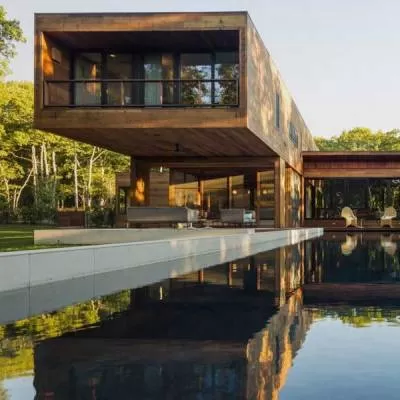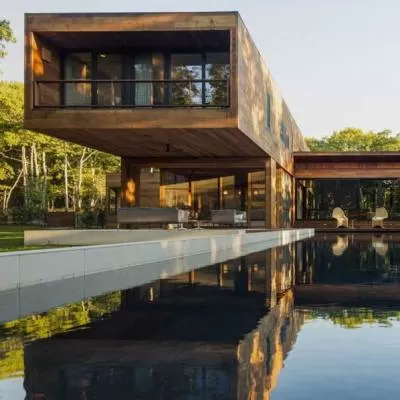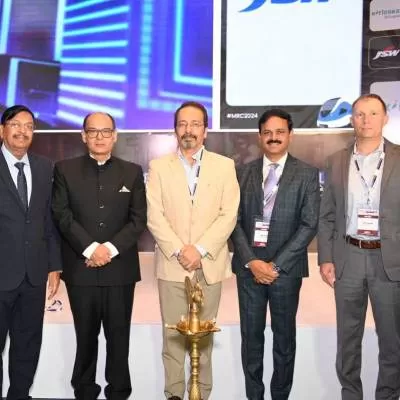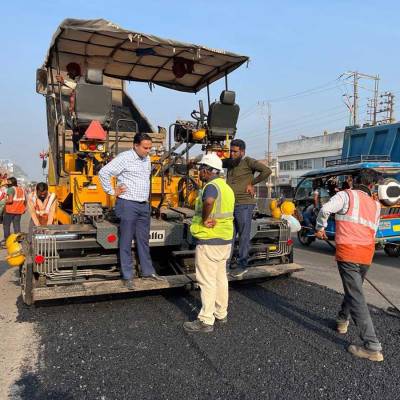- Home
- Real Estate
- Green blocks
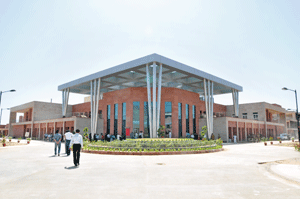
Green blocks
Here's how an institute initially conceptualised over 100,000 sq ft went on to span over 330,000 sq ft with a site area of about 16 acre - and become the ideal showcase for green technologies! In 2010, the Comptroller and Auditor General of India (CAG) awarded Dubai-based architect Arkiplan International and Jaipur-based green consultant Kamal Cogent Energy the job to build The International Centre for Environment Audit and Sustainable Development (iCED) in Jaipur. The result: the institute was successfully inaugurated on May 4, 2013, by the Vice President of India; registered under the GRIHA 5-Star rating, it is awaiting final certification. This will be followed by the official handing over of the project to CAG, informs Prasoon Shrivastava, Director, Arkiplan International. "Once this is done, we assume that the project is technically completed and the final submission will be made to GRIHA,ö he says.
iCED consists of a service block, an academic building, one hostel building, a sports block, bungalows, transit apartments and support staff facilities. Every building behaves differently as far as its green characters are concerned. While Shrivastava highlights that the challenge lay in air-conditioning the development, ensuring that the building envelope was as per the GRIHA requirement, he elaborates upon the other qualifying green features of the project in conversation with SHRIYAL SETHUMADHAVAN.
Studying space
Initially, based on their experience, CAG assumed that the construction would require around 100,000 sq ft. However, after detailed discussion on how and what they wanted to construct, we realised the project would require 330,000 sq ft. We started designing the project; our mandate was very clear that it had to be a GRIHA 5-Star rated building. So, starting from the building's orientation, we did a detailed analysis on the solar path, building envelope, depth of shading devices and whether there was a need for insulation.
Focused direction
At iCED, every building had to be analysed and oriented differently. We tried our best to orient the big buildings in the north-south direction. However, this was not practically possible for the smaller buildings. So, there are buildings diagonally facing east-west as well. The green building consultant had analysed each building as per the solar path and accordingly recommended energy conservation measures in terms of shading devices. Overhangs and fins have been used to enhance the building's envelope. Once we have a big window of about 6-8 ft, a 2-ft chajja may probably not help protect the building from sunlight. Hence, for some structures, we either put vertical fins at an angle against the sun's rays or placed horizontal fins depending on the design and the efficiency. This further reduces heat gain.
Energy boost
The building's orientation certainly has a huge impact on solar heating inside the building. Double-glazed glass, sourced from Saint Gobain, has been used for window fenestration along with UPVC windows, which have thermal barriers. This was for the building's envelope. As far as the circumference is concerned, LED lights have been used in many areas and an energy-efficient air-conditioning system adopted. The chilled water system installed is energy-efficient and HVAC load has been reduced. The pumps used for pneumatic water supply system are energy-efficient. Further, 30 per cent of the internal lighting load is achieved from the solar farm, which is a part of the project. Hundred per cent external lighting and hot water has been achieved from the same. Also, the institute has been designed for daylight. We ensured that except for the auditorium, the room depth is not more than 8-9 m. We have also introduced skylights for the meeting halls and demo labs. The courtyard has been designed in a way that the inernal corridors receive a lot of daylight. Further, you need not always design a project for daylight. One interesting feature we have introduced on the top floor corridors of the hostel block is light tunnels. Instead of providing daylight, light pipes are used. These are actually small pipes placed inside the slab. The top of the slab, which is exposed to the environment, has reflective glass through which daylight gets reflected towards the corridors.
Save water
First, we have a pneumatic way of supplying water in the buildings. This is a more efficient way of using water than having a gravity flow for the buildings. Second, low-flow fixtures and dual flush WCs with low flush rates have been fitted. This reduces the overall amount of water used. Then, there is a sewage treatment plant, which treats 100 per cent of the water up to the tertiary level. Once the treatment is done, the water is reused on site for irrigation purposes. This fulfils the landscape irrigation demand. And then, of course, green harvesting has been done all over the site. Whether it is the sewage treatment plant or rainwater harvesting system, no particular technology has been used. In the case of rainwater harvesting system, in areas like Jaipur, water easily penetrates into the ground. Also, rainwater levels are very low. So all we need to do is make a pit and the water, without being forced, easily goes into the ground. What's more, trees and plants of native species have been planted.
In the air
As the entire institute is air-conditioned, the only way to introduce fresh air into the building is through the air-conditioning systems. Thirty per cent fresh air is taken through our air-handling units as we have a separate duct coming in; it mixes 30 per cent of the fresh air with the air-conditioning system, which is further supplied to the rooms. We also have CO2 sensors to monitor CO2 levels inside the building. While the courtyard has been designed for ventilation on either side, we have ensured that fenestrations can be opened as required. We have also put trees towards the building's facade. So once the air travels towards the building, it passes through the trees and cools down before entering the building. Then, one of the most interesting technologies we have adopted is the earth air tunnel technique. Instead of air-conditioning the demonstration lab in the institutional building, we decided to opt for a natural cooling system. We made a 100-m-long tunnel (1.5 m in diameter and 12 ft below ground level); from the landscape area, air is absorbed from one side and travels 100 m under the ground until it reaches the building. Also, at the basement level, an air-handling unit handles the air that comes through the tunnel. This air is further supplied to the demonstration lab. So the air cools down as it travels 100 m below the ground and the end result is an ultimate cooling effect.
Materials play
Recycled materials like flyash have been extensively used in the project. Also, local stone has been used on the building's facade as well as flooring. Cement has been taken from a contractor who sources it from a plant near Jaipur. Local materials have also been used for paving pathways and the landscape. Hence, we have reduced a lot on transportation cost. Also, there is something called inbuilt energy in local materials. While preparing a material for usage, there is a lot of energy involved in it. So, built-in energy in local materials is much lower compared to manufactured materials and this is essentially what makes locally sourced material eco-friendly. In the case of insulation, 75-mm-thick insulation has been used inside the walls and 50-mm-thick insulation has been used for the roof. Extruded polystyrenes have been used for insulation because these do not allow the heat to transmit inside the space.
Add-ons
Further, we have used low-VOC paints and sealants for the entire project. During construction, going by the GRIHA guidelines, we ensured that the entire waste was managed on site. Much of this was used for the project itself. For example, stone has been used in pathways and landscape areas. As this was a huge site, it was a big challenge for us to conserve the top soil. Hence, soil produced from 60 cm depth was preserved and reused for the landscape area post construction.
Total cost and payback
The total estimated cost of construction is Rs 90 crore. The payback period has not yet been analysed because the intent here is not to see if it makes commercial sense but to build an institute, educate people about green, and showcase as many relevant technologies as possible so people can learn and use them in their projects, not only in India, but world over. Probably, once we are officially certified green by GRIHA, we may add three to four more technologies into the whole development.
Prasoon Shrivastava's perspective
"At present, the green building movement in India is a bit slow, especially because the private sector is not ready to adopt it. The primary reason is the increase in the project's initial cost. However, with initiatives by the government, more awareness will be created and hopefully the private sector will adopt similar systems as normal practice and not as an additional effort. Also, building green with a marketing agenda is not the apt approach. Green makes more sense as far as quality of life is concerned. It is very important that we conserve our environment and live inside a building that has better air quality and more efficient systems."
Project details:
Size of the project: 16 acre (Plot area); and 330,000 sq ft (total built-up area)
Cost: Rs 90 crore
Completion: 2013
Contractor: Rama Construction. Tel: 0251 11646 3290. Website: www.ramaconstructionplc.com
Architect/Planner: Arkiplan International Architects Pvt Ltd. Tel: 011-4645 8800. E-mail: info@arkiplaninternational.com, Website: www.arkiplan.co
Landscape architect: Integral Designs. Tel: 011- 2411 4500. E-mail: studio@integraldesigns.in Website: www.integraldesigns.in
Green consultant: Kamal Cogent & Energy. Tel: 0141-237 3184. E-mail: contact@kamalcogentenergy.com, Website: www.kamalcogentenergy.com Services consultant: AECOM (Spectral). Tel: 0120-404 9000. Website: www.aecom.com
HVAC contractor: BlueStar. Tel: 022-6665 4000. Website: www.bluestarindia.com
Structural consultant: Pioneer Consultant. Tel: 011-4356 0676.
External cladding consultant: HILTI. Tel: 011-4270 1111. Website: www.hilti.in
Elevators and escalators: Johnson. Tel: 044-2615 2200. E-mail: info@johnsonliftsltd.com, Website: www.johnsonliftsltd.com
Glazing: Saint Gobain. Tel: 044-2716 2832. Website: www.saint-gobain.co.in
Flooring/tiles: Kajaria. Tel: 011-2694 6409. E-mail: info@kajariaceramics.com, Website: www.kajariaceramics.com
Recently built in Jaipur, The International Centre for Environment Audit and Sustainable Development walks the green talk to achieve GRIHA's 5-Star rating. Here's how an institute initially conceptualised over 100,000 sq ft went on to span over 330,000 sq ft with a site area of about 16 acre - and become the ideal showcase for green technologies! In 2010, the Comptroller and Auditor General of India (CAG) awarded Dubai-based architect Arkiplan International and Jaipur-based green consultant Kamal Cogent Energy the job to build The International Centre for Environment Audit and Sustainable Development (iCED) in Jaipur. The result: the institute was successfully inaugurated on May 4, 2013, by the Vice President of India; registered under the GRIHA 5-Star rating, it is awaiting final certification. This will be followed by the official handing over of the project to CAG, informs Prasoon Shrivastava, Director, Arkiplan International. "Once this is done, we assume that the project is technically completed and the final submission will be made to GRIHA,ö he says. iCED consists of a service block, an academic building, one hostel building, a sports block, bungalows, transit apartments and support staff facilities. Every building behaves differently as far as its green characters are concerned. While Shrivastava highlights that the challenge lay in air-conditioning the development, ensuring that the building envelope was as per the GRIHA requirement, he elaborates upon the other qualifying green features of the project in conversation with SHRIYAL SETHUMADHAVAN. Studying space Initially, based on their experience, CAG assumed that the construction would require around 100,000 sq ft. However, after detailed discussion on how and what they wanted to construct, we realised the project would require 330,000 sq ft. We started designing the project; our mandate was very clear that it had to be a GRIHA 5-Star rated building. So, starting from the building's orientation, we did a detailed analysis on the solar path, building envelope, depth of shading devices and whether there was a need for insulation. Focused direction At iCED, every building had to be analysed and oriented differently. We tried our best to orient the big buildings in the north-south direction. However, this was not practically possible for the smaller buildings. So, there are buildings diagonally facing east-west as well. The green building consultant had analysed each building as per the solar path and accordingly recommended energy conservation measures in terms of shading devices. Overhangs and fins have been used to enhance the building's envelope. Once we have a big window of about 6-8 ft, a 2-ft chajja may probably not help protect the building from sunlight. Hence, for some structures, we either put vertical fins at an angle against the sun's rays or placed horizontal fins depending on the design and the efficiency. This further reduces heat gain. Energy boost The building's orientation certainly has a huge impact on solar heating inside the building. Double-glazed glass, sourced from Saint Gobain, has been used for window fenestration along with UPVC windows, which have thermal barriers. This was for the building's envelope. As far as the circumference is concerned, LED lights have been used in many areas and an energy-efficient air-conditioning system adopted. The chilled water system installed is energy-efficient and HVAC load has been reduced. The pumps used for pneumatic water supply system are energy-efficient. Further, 30 per cent of the internal lighting load is achieved from the solar farm, which is a part of the project. Hundred per cent external lighting and hot water has been achieved from the same. Also, the institute has been designed for daylight. We ensured that except for the auditorium, the room depth is not more than 8-9 m. We have also introduced skylights for the meeting halls and demo labs. The courtyard has been designed in a way that the inernal corridors receive a lot of daylight. Further, you need not always design a project for daylight. One interesting feature we have introduced on the top floor corridors of the hostel block is light tunnels. Instead of providing daylight, light pipes are used. These are actually small pipes placed inside the slab. The top of the slab, which is exposed to the environment, has reflective glass through which daylight gets reflected towards the corridors. Save water First, we have a pneumatic way of supplying water in the buildings. This is a more efficient way of using water than having a gravity flow for the buildings. Second, low-flow fixtures and dual flush WCs with low flush rates have been fitted. This reduces the overall amount of water used. Then, there is a sewage treatment plant, which treats 100 per cent of the water up to the tertiary level. Once the treatment is done, the water is reused on site for irrigation purposes. This fulfils the landscape irrigation demand. And then, of course, green harvesting has been done all over the site. Whether it is the sewage treatment plant or rainwater harvesting system, no particular technology has been used. In the case of rainwater harvesting system, in areas like Jaipur, water easily penetrates into the ground. Also, rainwater levels are very low. So all we need to do is make a pit and the water, without being forced, easily goes into the ground. What's more, trees and plants of native species have been planted. In the air As the entire institute is air-conditioned, the only way to introduce fresh air into the building is through the air-conditioning systems. Thirty per cent fresh air is taken through our air-handling units as we have a separate duct coming in; it mixes 30 per cent of the fresh air with the air-conditioning system, which is further supplied to the rooms. We also have CO2 sensors to monitor CO2 levels inside the building. While the courtyard has been designed for ventilation on either side, we have ensured that fenestrations can be opened as required. We have also put trees towards the building's facade. So once the air travels towards the building, it passes through the trees and cools down before entering the building. Then, one of the most interesting technologies we have adopted is the earth air tunnel technique. Instead of air-conditioning the demonstration lab in the institutional building, we decided to opt for a natural cooling system. We made a 100-m-long tunnel (1.5 m in diameter and 12 ft below ground level); from the landscape area, air is absorbed from one side and travels 100 m under the ground until it reaches the building. Also, at the basement level, an air-handling unit handles the air that comes through the tunnel. This air is further supplied to the demonstration lab. So the air cools down as it travels 100 m below the ground and the end result is an ultimate cooling effect. Materials play Recycled materials like flyash have been extensively used in the project. Also, local stone has been used on the building's facade as well as flooring. Cement has been taken from a contractor who sources it from a plant near Jaipur. Local materials have also been used for paving pathways and the landscape. Hence, we have reduced a lot on transportation cost. Also, there is something called inbuilt energy in local materials. While preparing a material for usage, there is a lot of energy involved in it. So, built-in energy in local materials is much lower compared to manufactured materials and this is essentially what makes locally sourced material eco-friendly. In the case of insulation, 75-mm-thick insulation has been used inside the walls and 50-mm-thick insulation has been used for the roof. Extruded polystyrenes have been used for insulation because these do not allow the heat to transmit inside the space. Add-ons Further, we have used low-VOC paints and sealants for the entire project. During construction, going by the GRIHA guidelines, we ensured that the entire waste was managed on site. Much of this was used for the project itself. For example, stone has been used in pathways and landscape areas. As this was a huge site, it was a big challenge for us to conserve the top soil. Hence, soil produced from 60 cm depth was preserved and reused for the landscape area post construction. Total cost and payback The total estimated cost of construction is Rs 90 crore. The payback period has not yet been analysed because the intent here is not to see if it makes commercial sense but to build an institute, educate people about green, and showcase as many relevant technologies as possible so people can learn and use them in their projects, not only in India, but world over. Probably, once we are officially certified green by GRIHA, we may add three to four more technologies into the whole development. Prasoon Shrivastava's perspective "At present, the green building movement in India is a bit slow, especially because the private sector is not ready to adopt it. The primary reason is the increase in the project's initial cost. However, with initiatives by the government, more awareness will be created and hopefully the private sector will adopt similar systems as normal practice and not as an additional effort. Also, building green with a marketing agenda is not the apt approach. Green makes more sense as far as quality of life is concerned. It is very important that we conserve our environment and live inside a building that has better air quality and more efficient systems." Project details: Size of the project: 16 acre (Plot area); and 330,000 sq ft (total built-up area) Cost: Rs 90 crore Completion: 2013 Contractor: Rama Construction. Tel: 0251 11646 3290. Website: www.ramaconstructionplc.com Architect/Planner: Arkiplan International Architects Pvt Ltd. Tel: 011-4645 8800. E-mail: info@arkiplaninternational.com, Website: www.arkiplan.co Landscape architect: Integral Designs. Tel: 011- 2411 4500. E-mail: studio@integraldesigns.in Website: www.integraldesigns.in Green consultant: Kamal Cogent & Energy. Tel: 0141-237 3184. E-mail: contact@kamalcogentenergy.com, Website: www.kamalcogentenergy.com Services consultant: AECOM (Spectral). Tel: 0120-404 9000. Website: www.aecom.com HVAC contractor: BlueStar. Tel: 022-6665 4000. Website: www.bluestarindia.com Structural consultant: Pioneer Consultant. Tel: 011-4356 0676. External cladding consultant: HILTI. Tel: 011-4270 1111. Website: www.hilti.in Elevators and escalators: Johnson. Tel: 044-2615 2200. E-mail: info@johnsonliftsltd.com, Website: www.johnsonliftsltd.com Glazing: Saint Gobain. Tel: 044-2716 2832. Website: www.saint-gobain.co.in Flooring/tiles: Kajaria. Tel: 011-2694 6409. E-mail: info@kajariaceramics.com, Website: www.kajariaceramics.com





